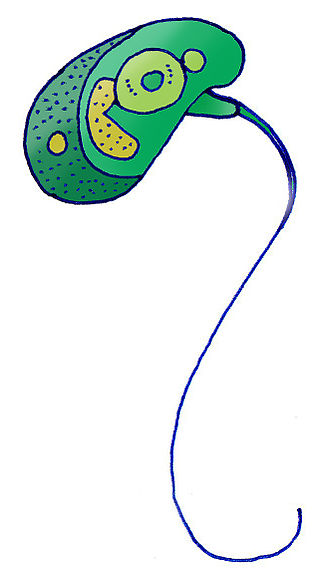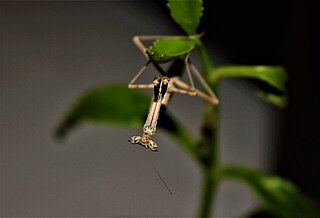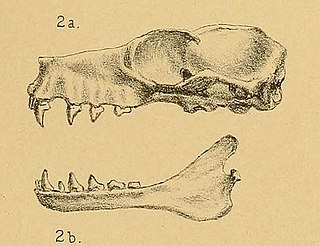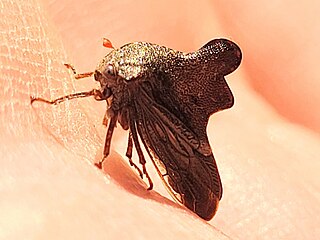
The National Center for Biotechnology Information (NCBI) is part of the United States National Library of Medicine (NLM), a branch of the National Institutes of Health (NIH). It is approved and funded by the government of the United States. The NCBI is located in Bethesda, Maryland, and was founded in 1988 through legislation sponsored by US Congressman Claude Pepper.

Mamiellales are an order of green algae in the class Mamiellophyceae. Their cells and flagella are covered with spiderweb-like scales of several types. Some species lack scales but possess pigments similar to those of the scale-bearing species.

Oxyothespis is a genus of praying mantis in the family Toxoderidae. Members of this genus have been called grass mantises.

The Taiwanese brown-toothed shrew is a species of shrew in the tribe Nectogalini. It is found only in Taiwan. It prefers dense ground cover in forests and subalpine shrublands in high mountains of central Taiwan. Its placement in Episoriculus has been questioned, with genetic analysis finding that it is more basal within Nectogalini than other members of Episoriculus.

The minor epauletted fruit bat is a species of megabat in the family Pteropodidae. It is found in Zambia, Tanzania, Mozambique and Kenya.
Pleuroloma cala is a species in the order Polydesmida, in the class Diplopoda ("millipedes"). Pleuroloma cala is found in North America.
Seira domestica is a species in the family Entomobryidae, in the order Entomobryomorpha.

Arigomphus maxwelli is a dragonfly in the genus Arigomphus, in the family Gomphidae ("clubtails"). A common name for Arigomphus maxwelli is "bayou clubtail". Arigomphus maxwelli is found in North America.

Trimerotropis fontana is a grasshopper in the subfamily Oedipodinae, in the family Acrididae. A common name for Trimerotropis fontana is "fontana grasshopper". Trimerotropis fontana is found in North America.

Hoplitis anthocopoides is a species in the family Megachilidae, in the order Hymenoptera . The distribution range of Hoplitis anthocopoides includes Africa, Europe, Northern Asia, and North America.
Yuyuevirus is a genus of negative-strand RNA viruses which infect invertebrates. Member viruses have bisegmented genomes. It is the only genus in the family Yueviridae, which in turn is the only family in the order Goujianvirales and class Yunchangviricetes. Two species are recognized: Beihai yuyuevirus and Shahe yuyuevirus.
Alphamononivirus is a genus of enveloped, positive-strand RNA viruses in the order Nidovirales which infect planarian flatworms. Member virus planarian secretory cell nidovirus (PSCNV) has the largest known nonsegmented RNA genome of 41.1kb of any RNA virus. The genus is monotypic. It contains the subgenus Dumedivirus, which contains only one species, Planidovirus 1. Alphamononivirus is also the only member of the subfamily Mononivirinae, which in turn is the only member of family Mononiviridae, which likewise is the only member of the Monidovirineae suborder.

Heliria is a genus of treehoppers in the family Membracidae.
The Khasian leaf-nosed bat is a species of bat in the family Hipposideridae. It is endemic to Meghalaya, India. It is a cave-dwelling bat.
The Alashanian pipistrelle is a species of bat in the family Vespertilionidae. It is found in China, South Korea, Mongolia, Japan, and Russia.
Miliusa macrocarpa is a species of plant in the family Annonaceae, that is native to Nepal and India.
Campocraspedon is a genus of ichneumonid wasp in the insect order Hymenoptera. It comprises six species.
Otothyropsis biamnicus is a species of catfish in the family Loricariidae. It is native to South America, where it occurs in tributaries of the Iguazu River and the Tibagi River, which are both in the Paraná River basin of Brazil. It is noted to be commensal with midge larvae of the family Chironomidae, which attach to the gill openings or more rarely the cleithrum of the fish. It reaches 4 cm SL. The specific epithet of this species, biamnicus, roughly translates to "inhabitant of two rivers", which refers to the species' distribution in tributaries of two different rivers.

Heliria cornutula is a species of treehopper. It belongs to the genus Heliria. It is associated with the sweetgum.

Heliria praealta is a species of treehopper in the family Membracidae. It is found in the western United States and Canada.









